Engineers Without Borders work inspires senior thesis
Senior designs water quality instrument to assist developing countries
May 22, 2015
In an effort to create an instrument to measure water quality, Cort Hammond, ’15, spent about two years working on his senior thesis, which was inspired by his work with Engineers Without Borders.
Two years ago, Hammond joined Engineers Without Borders and trekked to Guatemala to build biosand filters to improve water quality in developing countries.
These filters were the inspiration for Hammond’s thesis. He wondered if there was a good way to determine water quality after using the filters.
“The biosand filters don’t kill everything,” Hammond said. “I was hoping to get more at the real value [of] what was coming out. A number of small side experiments eventually led to what I ended up doing, which was an assay that involves a micropore filter that you screw onto a syringe and you filter water through there and see how fast that clogs, and the speed at which it clogs is proportional to the number of bacteria in the water.”
Hammond’s micropore-filter method of monitoring water quality is more accessible and affordable than similar water quality monitoring methods, which makes a device like his easier for developing countries to use.
“The idea is that instead of doing a bacterial assay which involves plating, incubating and counting bacteria, you would do this in 15 minutes and it would save time and be cheaper. You need a lab to do a bacteriological assay well and you need somewhat sterile conditions. That’s just so hard to find in a developing country,” Hammond said.
Hammond sees potential in the product for possible distribution and use in the field.
“The product of this thesis is really oriented towards something that the World Health Organization would hand out a kit and a pamphlet and anybody could do it,” Hammond said. “They would just have the kit and they’d perform the test and it would tell them a ballpark of the water quality.”
Hammond’s thesis advisor, Professor Jonathan Erickson, is also very excited about the success of Hammond’s project and believes that the product has potential, though there are still some unanswered questions.
“[Hammond] has made excellent progress and the results of his experiments are very promising,” Erickson said. “His thesis work clearly shows that bacteria counts and water quality can be correlated to precisely how fast a membrane clogs when being biosand filter effluent is pushed through it. It’s a beautifully simple system to operate and it’s cheap, so it definitely has potential.”
Hammond’s project produces a water quality reading that falls into one of four categories reflecting the quality of the water. This device gives a generalized assessment of water quality and is as simple a method of monitoring quality.
His proposed kit would be very accessible and easy to use, which could be very helpful for monitoring water quality in developing countries.
After graduation, Hammond will be working with Apptech Solutions, a small engineering firm in Salem, Va. that focuses on modular wastewater and water treatment reactors.
Although Hammond is graduating, Erickson hopes that his thesis work will not stop here.
“As with any good technical work, his thesis raised more questions to pursue in the future,” Erickson said. “Hopefully, other students will continue with this line of research to answer some of these questions.”
Hammond also hopes to revisit his project in the future. He anticipates being busy with his work with Apptech Solutions but thinks that his thesis project needs to have a little more field research support.
Hammond said that, ultimately, it would be great to be able to bring his project to the World Health Organization and make it available to people in developing countries.












